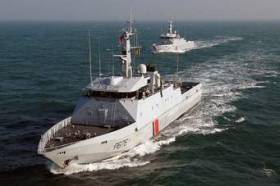Displaying items by tag: Dublin, St Patrick's Day Festival
Flamingo Flies French Tricolor In Advance of Patrick's Day
#FrenchNavy– PSP Flamant (P676) a French Navy fisheries and coastguard patrol vessel docked in Dublin Port in advance of celebrating tomorrow's St. Patrick’s Day, writes Jehan Ashmore.
The OPV54 or 'Cormoran' bird class Flamant flying the 'tricolor' (adopted during the French Revolution) departed her homeport of Cherbourg and docked in the Irish capital this morning. It took two days for the 22 knot capable vessel to reach Dublin Bay where the naval visitor was greeted by the Liffey, a port pilot cutter.
A crew of just 20 personnel including tree trainees sailed upriver to the city centre at Sir John Rogersons Quay. Further along the south quays is O’Connell Bridge to where tomorrow’s largest St. Patrick's festival parade is to cross the Liffey to much fanfare in this centenary year of the 1916 Rising.
Flamant is to remain in port till Saturday morning and return to waters where the vessel is principally tasked in patrolling and surveillance duties in the zone économique exclusive (ZEE).
The OPV built by Constructions Mécaniques de Normandie also located in Cherbourg is from where the vessel sets off on these ZEE patrols. This involves patrols extending to 200 nautical miles offshore into the Atlantic Ocean.
She is equipped with a RIB concealed in a dock well which is accessed from a stern-lifting door.
























































